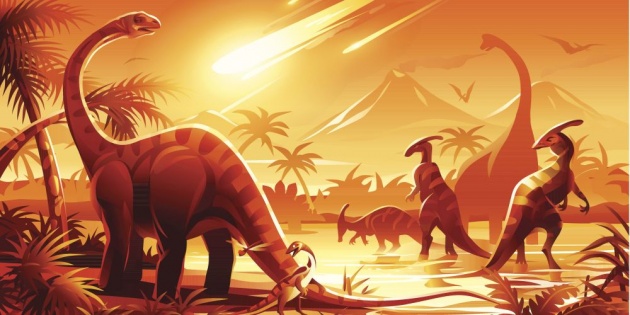Meteorite Impact and Dinosaur Extinction

There is increasing evidence that the impacts of meteorites have had important effects on Earth, particularly in the field of biological evolution. Such impacts continue to pose a natural hazard to life on Earth. Twice in the twentieth century, large meteorite objects are known to have collided with Earth.
If an impact is large enough, it can disturb the environment of the entire Earth and cause an ecological catastrophe. The best-documented such impact took place 65 million years ago at the end of the Cretaceous period of geological history. This break in Earth’s history is marked by a mass extinction, when as many as half the species on the planet became extinct. While there are a dozen or more mass extinctions in the geological record, the Cretaceous mass extinction has always intrigued paleontologists because it marks the end of the age of the dinosaurs. For tens of millions of years, those great creatures had flourished. Then, suddenly, they disappeared.
The body that impacted Earth at the end of the Cretaceous period was a meteorite with a mass of more than a trillion tons and a diameter of at least 10 kilometers. Scientists first identified this impact in 1980 from the worldwide layer of sediment deposited from the dust cloud that enveloped the planet after the impact. This sediment layer is enriched in the rare metal iridium and other elements that are relatively abundant in a meteorite but very rare in the crust of Earth. Even diluted by the terrestrial material excavated from the crater, this component of meteorites is easily identified. By 1990 geologists had located the impact site itself in the Yucatán region of Mexico. The crater, now deeply buried in sediment, was originally about 200 kilometers in diameter.
This impact released an enormous amount of energy, excavating a crater about twice as large as the lunar crater Tycho. The explosion lifted about 100 trillion tons of dust into the atmosphere, as can be determined by measuring the thickness of the sediment layer formed when this dust settled to the surface. Such a quantity of material would have blocked the sunlight completely from reaching the surface, plunging Earth into a period of cold and darkness that lasted at least several months. The explosion is also calculated to have produced vast quantities of nitric acid and melted rock that sprayed out over much of Earth, starting widespread fires that must have consumed most terrestrial forests and grassland. Presumably, those environmental disasters could have been responsible for the mass extinction, including the death of the dinosaurs.
Several other mass extinctions in the geological record have been tentatively identified with large impacts, but none is so dramatic as the Cretaceous event. But even without such specific documentation, it is clear that impacts of this size do occur and that their results can be catastrophic. What is a catastrophe for one group of living things, however, may create opportunities for another group. Following each mass extinction, there is a sudden evolutionary burst as new species develop to fill the ecological niches opened by the event.
Impacts by meteorites represent one mechanism that could cause global catastrophes and seriously influence the evolution of life all over the planet. According to some estimates, the majority of all extinctions of species may be due to such impacts. Such a perspective fundamentally changes our view of biological evolution. The standard criterion for the survival of a species is its success in competing with other species and adapting to slowly changing environments. Yet an equally important criterion is the ability of a species to survive random global ecological catastrophes due to impacts.
Earth is a target in a cosmic shooting gallery, subject to random violent events that were unsuspected a few decades ago. In 1991 the United States Congress asked NASA to investigate the hazard posed today by large impacts on Earth. The group conducting the study concluded from a detailed analysis that impacts from meteorites can indeed be hazardous. Although there is always some risk that a large impact could occur, careful study shows that this risk is quite small.



